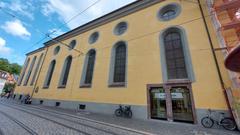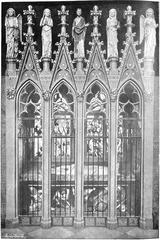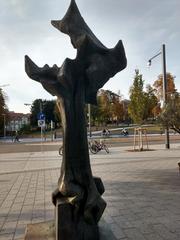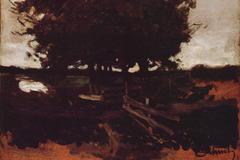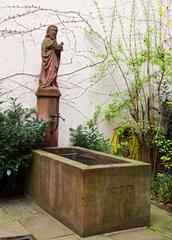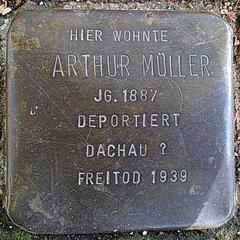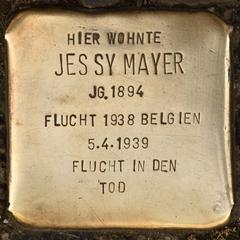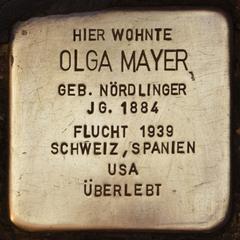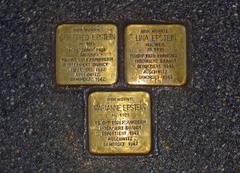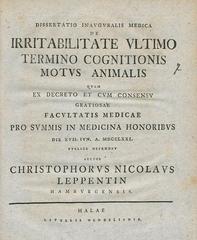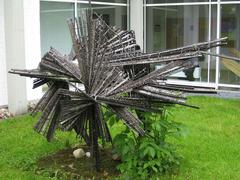Freiburg Botanical Garden: Visiting Hours, Tickets, and Comprehensive Visitor Guide
Date: 04/07/2025
Introduction
Nestled in the heart of Freiburg im Breisgau, Germany, the Freiburg Botanical Garden is a historic and vibrant green oasis, renowned for its centuries-old legacy, scientific research, and commitment to sustainability. Established in 1620 as the Hortus Medicus by the University of Freiburg, this living museum is one of the oldest botanical gardens in Germany. Over the centuries, it has evolved into a center for conservation, education, and public engagement, offering visitors access to over 8,000 plant species from around the world.
Whether you’re a botany enthusiast, researcher, student, or a casual visitor seeking tranquility, the Freiburg Botanical Garden provides a multifaceted experience. This guide offers practical information on visiting hours, admission, accessibility, key attractions, sustainability initiatives, and travel tips to help you plan your visit to this remarkable institution.
For the latest updates and detailed planning, visit the official Freiburg Botanical Garden website and explore broader city highlights via Freiburg Tourism.
Contents
- Introduction
- Historical Overview
- Garden Layout and Key Attractions
- Scientific and Cultural Significance
- Sustainability Practices
- Community Engagement and Education
- Visitor Information
- Frequently Asked Questions (FAQ)
- Summary and Final Tips
- Sources
Historical Overview
Early Foundations (1620–1677)
The Freiburg Botanical Garden traces its roots to 1620, when the University of Freiburg established the first “Hortus Medicus” to support medical and botanical education. Despite challenges such as the Thirty Years’ War and relocations due to military fortification, the garden persisted, laying the groundwork for centuries of botanical advancement.
Enlightenment and Expansion (1766–1878)
In 1766, a new garden was established near the Dreisam River, expanding to 2.7 hectares and introducing greenhouses for exotic species. Despite periodic flooding and political upheaval, the garden flourished under visionary directors, notably Franz Joseph Lambert Baader and Julius von Sachs.
Public Engagement and Modernization (1878–1912)
Flooding prompted a move in 1878 to the Institutes Quarter, increasing public accessibility and expanding educational programs. In 1912, the garden relocated to its current site on Schänzlestraße, officially opening in 1914 with specialized greenhouses and a diverse array of plant collections.
War, Reconstruction, and Innovation (20th Century–Today)
Though damaged during World War II, the garden was restored post-war and modernized. Since 2002, it has become a center for advanced research in plant biomechanics and biomimetics under Prof. Dr. Thomas Speck, blending tradition with scientific innovation.
Garden Layout and Key Attractions
General Structure and Accessibility
Located in Freiburg’s Herdern district, the garden covers approximately 2.7 hectares. Visitors enter through the main gate and follow accessible, well-marked pathways leading to thematic sections. The flat terrain, benches, and shaded seating ensure comfort and accessibility for all.
Outdoor Collections
- Systematic Section: Beds arranged by botanical relationships, labeled for educational value.
- Geographical Sections: Flora grouped by continental origin (Europe, Asia, Americas).
- Ecological Habitats: Alpine meadows, wetlands, and flower meadows supporting biodiversity.
- Medicinal and Useful Plants: Highlighting the garden’s roots as a “Hortus Medicus.”
- Ponds and Wetlands: Home to aquatic plants and local wildlife.
(Freiburg Botanical Garden historical sites)
Greenhouse Complex
- Tropical House: Orchids, bromeliads, cacao, and coffee.
- Subtropical House: Mediterranean, South African, and Australian flora.
- Desert House: Cacti and succulents.
- Aquatic Plant House: Water lilies and wetland displays.
- Special Collections: Rare and endangered plants, and those used in biomimetic research.
Greenhouse hours: Monday–Thursday 11:00–15:30; Sundays and holidays 14:00–16:00. (Closed Fridays and Saturdays; check for seasonal changes.)
(Freiburg Botanical Garden tickets)
Educational and Research Facilities
As part of the University of Freiburg, the garden is a hub for research in plant biomechanics and biomimetics. Informational panels, QR codes, and weekly plant consultations (Wednesdays, 13:00–15:00) are available to deepen your visit.
(Freiburg Botanical Garden plant consultation)
Scientific and Cultural Significance
Research and Conservation
The garden supports research in plant systematics, ecology, physiology, and climate adaptation. It plays a key role in ex situ conservation of rare and endangered species, seed banking, and collaborations with global networks like Botanic Gardens Conservation International.
Education and Public Outreach
An integral part of the University’s curriculum, the garden offers hands-on learning for students and diverse public education programs, including guided tours, workshops, and thematic exhibitions. Citizen science projects and interactive displays foster a culture of environmental stewardship.
Cultural and Regional Impact
The garden is a cultural landmark, reflecting Freiburg’s green city ethos. It serves as a recreational space, a site of community pride, and a bridge connecting science, heritage, and everyday urban life.
Sustainability Practices
Integration with Freiburg’s Green City Movement
The garden embodies Freiburg’s reputation as a model for sustainable urban living through its use of renewable energy, eco-friendly landscaping, and innovative water management. It supports biodiversity, carbon sequestration, and climate resilience.
Biodiversity and Energy Initiatives
With more than 8,000 species, the garden’s living collections contribute to global conservation. Energy-efficient greenhouses and likely solar installations align with Freiburg’s status as Germany’s “Solar Capital.”
Water and Landscape Management
The Water Garden demonstrates sustainable water use, including rainwater harvesting and cultivation of native aquatic plants. Landscaping emphasizes drought-resistant flora and composting.
Sustainable Mobility
Visitors are encouraged to use public transit or bicycles, with the garden providing secure bike parking and clear signage.
Community Engagement and Education
Public Programs
The garden offers guided tours, workshops, lectures, and seasonal events for all ages, making environmental awareness accessible and engaging.
Volunteer and Citizen Science
Residents and students can join volunteer programs and citizen science initiatives, fostering community and ecological literacy.
Partnerships
Collaboration with local authorities and international organizations strengthens the garden’s role in citywide sustainability and conservation.
Visitor Information
- Opening Hours: Outdoor areas: Daily 8:00–18:00; Greenhouses: Mon–Thu 11:00–15:30, Sun & holidays 14:00–16:00 (Closed Fri & Sat).
- Admission: Free for all visitors. Donations welcome.
- Location: Schänzlestraße 1, 79104 Freiburg im Breisgau. Easily accessible via tram, bus, or bicycle.
- Accessibility: Wheelchair-friendly paths, benches, barrier-free restrooms, and multilingual signage.
- Travel Tips: Combine your visit with trips to the Freiburg Minster, Schlossberg hill, and the historic old town.
- Events: Guided tours, plant fairs, workshops, and special exhibitions are offered regularly; check the official website for details.
Frequently Asked Questions (FAQ)
Q: What are the Freiburg Botanical Garden opening hours?
A: Outdoor areas: Daily 8:00–18:00. Greenhouses: Mon–Thu 11:00–15:30; Sun & holidays 14:00–16:00; closed Fri & Sat.
Q: Is admission free?
A: Yes, entry is free. Some events or workshops may require tickets.
Q: Are guided tours available?
A: Yes, regular tours and workshops are available. Check the official website for current schedules.
Q: Is the garden accessible for people with mobility issues?
A: Yes, the garden is wheelchair-accessible, with barrier-free paths and facilities.
Q: Can I take photographs?
A: Yes, photography for personal use is welcome. Contact the garden for commercial photography permissions.
Q: Are pets allowed?
A: No, to protect plant collections, pets are not permitted (service animals excepted).
Q: How do I get there by public transport?
A: Take tram lines 1 or 3 to the ‘Botanischer Garten’ stop.
Q: Are there facilities for cyclists?
A: Yes, secure bicycle parking is provided.
Summary and Final Tips
The Freiburg Botanical Garden is a distinguished destination that combines centuries of botanical tradition, innovative research, and public engagement. Its accessible design, free admission, and rich plant collections make it a must-visit for those seeking both relaxation and inspiration in nature. As a flagship for Freiburg’s sustainability ethos, the garden exemplifies environmental stewardship and community participation.
To get the most from your visit:
- Check the official website for up-to-date information on events and opening hours.
- Download the Audiala app for guided audio tours.
- Explore nearby attractions in Freiburg for a full day of cultural and natural discovery.
Enhance your experience with digital maps and virtual tours available online or via QR codes on-site.
Sources and Further Reading
- Freiburg Botanical Garden: Visiting Hours, Tickets, History & Travel Tips (official website)
- University of Freiburg Botanical Garden: Visiting Hours, Historical Significance, and Visitor Guide (ibnbattutatravel.com)
- Freiburg Botanical Garden Visiting Hours, Tickets, and Attractions (Botanischer Garten Freiburg)
- Freiburg Botanical Garden: Visiting Hours, Tickets, and Sustainability Highlights (TOMs FLOWer CLUB)
- Embracing Sustainability: The Story of Freiburg’s Green City Movement (BrieflyPedia)
- Botanical Gardens and Their Scientific Role (ScienceDirect)
- Freiburg Tourism Official Site (Freiburg Tourism)
- Greener Future Initiative (Greener Future Initiative)
- Green City Times (Green City Times)
